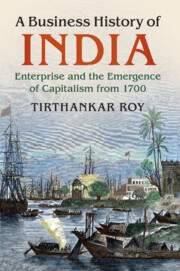Book contents
- A Business History of India
- A Business History of India
- Copyright page
- Dedication
- Contents
- Figures
- Maps
- Tables
- Boxes
- Preface
- 1 Introduction
- 2 The Baseline at 1700
- 3 The Indian Ocean Sphere: 1700–1850
- 4 Capital and Empire (1850–1930)
- 5 Capital and Empire (1850–1930)
- 6 State and Industrialisation: 1930–1950
- 7 State and Industrialisation: 1950–1980
- 8 Revival: 1980–2000
- 9 Capital and Globalisation: 2000–2015
- 10 Conclusion
- References
- Index
7 - State and Industrialisation: 1950–1980
Published online by Cambridge University Press: 20 March 2018
- A Business History of India
- A Business History of India
- Copyright page
- Dedication
- Contents
- Figures
- Maps
- Tables
- Boxes
- Preface
- 1 Introduction
- 2 The Baseline at 1700
- 3 The Indian Ocean Sphere: 1700–1850
- 4 Capital and Empire (1850–1930)
- 5 Capital and Empire (1850–1930)
- 6 State and Industrialisation: 1930–1950
- 7 State and Industrialisation: 1950–1980
- 8 Revival: 1980–2000
- 9 Capital and Globalisation: 2000–2015
- 10 Conclusion
- References
- Index
Summary
Protectionism was limited and conditional in the interwar period. The emphasis on industrialisation did not devalue the role of trade. National policy after 1947 changed the balance. It prioritised industrialisation, prioritised the production of machinery and chemicals in India, and devalued traditional activities like textiles and trade. State regulation of markets had increased in extent during World War II, and at the end of the war, the measures stayed on and acquired a developmental meaning. Breaking with the past, the regime increased the role of the state and reduced the role of the world economy as the driver of economic development.
Protectionist industrialisation delivered unprecedented opportunity to established domestic groups to diversify in the priority areas, and away from the older foundations of capitalist enterprise, trade, and textiles. Government efforts sharply raised industrial investment, and rewarded entrepreneurship with the permission to buy technology abroad through collaborations. This process favoured the already established conglomerates, who started production of machinery, chemicals, cement, and metals. It also nurtured many offbeat enterprises, and encouraged little known business groups to become conglomerates.
But protectionist industrialisation came with two types of cost. First, the closed economy hurt business formerly integrated with the world economy. Thus, the corporate textile industry went bankrupt, trade and banking were partnationalised, part-regulated, and part-outlawed, and restrictions were imposed on cross-border capital and labour movements damaging the managing agency companies. In the process, some of the traditional sources of investment funds, like profits from foreign trade, played a reduced role in the new regime. Second, the regime compromised macroeconomic stability. Whereas earlier India exported agricultural commodities and bought machines and services with the proceeds, now traditional exports were restrained to conserve investment funds, even when the decision to go for heavy industry needed more imports than before. With the repression of trade, textiles, and global firms, the capacity to export and earn exchange had been impaired. Banks were under pressure to lend to new clients of uncertain capacity, such as peasants, and when they did not comply easily, were nationalised. In this way, the economy's capacity to pay for investment was impaired. Repeated shocks from the world economy (1967, 1973, 1979, and 1991) underscored this obvious fact.
- Type
- Chapter
- Information
- A Business History of IndiaEnterprise and the Emergence of Capitalism from 1700, pp. 153 - 202Publisher: Cambridge University PressPrint publication year: 2018



